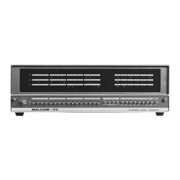Announced in 1972, this was the first minicomputer made by Mitsubishi Electric. It achieved the highest performance among Japanese made machines, ultra-compactness and lightweight, and high-reliability.
Core memory with 16-bit words and 1 parity bit was used for main memory, and its cycle time was 0.8µs. The CPU had high-speed performance of 0.8µs for addition and subtraction, 5.6µ s for multiplication and 6.7µs for division. The machine used a multi-accumulator system, and also had pushdown stack capability.
The machine was equipped standard with all the built-in capabilities necessary for practical use as a minicomputer, including multiplication/division circuits, memory parity checking, an interrupt mechanism with 16-level and a power supply protection mechanism. The entire basic configuration (4K-word core memory and power supply) was housed in a basic cabinet with dimensions 150mm (height) x 480mm (width) x 550mm (depth). The machine was ultra-compact in size while providing adequate space to house 2 or 3 additional mechanisms freely chosen by the user. Weight was a light 30kg.
High-reliability was achieved by using a simple system construction (which involved simply connecting modules mounted on large boards at the back panel), logic circuits based primarily on MSI (mid-scale integrated circuits), and an operation panel employing light emitting diodes.
The types of software which could be used were: BASIC and JIS-3000, JIS-5000 and JIS-7000 FORTRANs.


